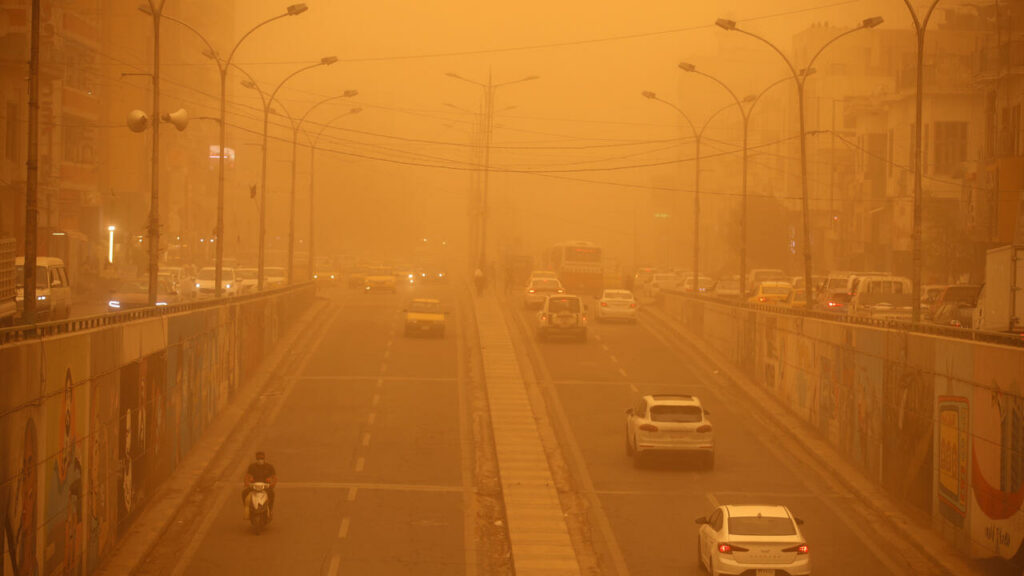Published on :
Since mid-April, Iraq has suffered seven sandstorms. The phenomenon, which continues to worsen year by year, represents a serious threat to the health and economy of the countries of the Middle East. In question, global warming, desertification, but also armed conflicts.
Nothing seems to be able to stop them. Within minutes, they engulf entire cities in a thick fog of orange dust. The inhabitants suffocate and outside, life stops. Sandstorms have always been part of the daily life of Iraqis, but their frequency and intensity have continued to increase in recent years, amplified by global warming, desertification and armed conflicts.
Since April, the country has already experienced seven sandstorms. The latest caused the death of one person on Thursday and the hospitalization of 5,000 others for respiratory problems.
« The majority have left the hospitals », however, said the spokesman for the Ministry of Health, Seif al-Badr, in a press release, referring to cases which for the most part are « of medium or low intensity ».
The most affected are people with « chronic respiratory diseases such as asthma », or « the elderly » who suffer in particular from « heart failure », he added.
{{ scope.counterText }}
{{ scope.legend }}
© {{ scope.credits }}
{{ scope.counterText }}
{{ scope.legend }}
© {{ scope.credits }}
Billions of dollars gone to dust
Beyond these health consequences, these extreme phenomena are a wound for an Iraqi economy that is already bloodless. The airports of Baghdad, Najaf and Erbil in Kurdistan were thus forced to briefly suspend their flights due to the lack of visibility.
As the World Meteorological Organization reports, sand also has many adverse effects on agriculture. It decreases yields by smothering seedlings, reduces photosynthesis and increases soil erosion.
In addition, dust deposits promote the obstruction of irrigation canals or the deterioration of the quality of water in rivers and rivers.
During these storms, many activities have to be interrupted, causing the countries of the region to lose astronomical sums. According to the UN, each year, North Africa and the Middle East see nearly 13 billion GDP crumble to dust.
In September 2015, a giant sandstorm blanketed much of the Middle East, leading to airport closures, road accidents and numerous hospital admissions.
And things are expected to continue to get worse. Iraq, during the next two decades, could experience « 272 days of dust » per year and in 2050, the threshold of 300 days per year will be reached, assured in early April a senior official of the Ministry of the Environment.
The water war
Typically, sandstorms occur when strong winds blow large amounts of sand and dust from dry, bare ground into the atmosphere.
However, these arid and semi-arid soils are gaining ground in Iraq and the Middle East, particularly under the effect of global warming. With rising temperatures, sometimes exceeding 50 degrees, and low rainfall, periods of drought are becoming more frequent.
Moreover, the fierce competition between the States of the region to appropriate water resources provides another explanation.
As Middle East Eye points out, « Turkey’s construction of the gigantic Atatürk dam upstream of the Euphrates and the Ilısu dam on the Tigris is decried insofar as they contribute to reducing water flows in two major rivers in the region and are causing land to dry up further south in Iraq ».
Iraq has also undertaken numerous dam constructions in recent years, as has its neighbor Iran, without much consideration for resource management.
According to some experts, the successive wars in Iraq could also be an aggravating factor. Indeed, during an armed conflict, urban destruction leaves the land bare, favoring the appearance of storms. Added to this are population displacements that lead to the abandonment of cultivated land.
The example of China and Senegal
To combat sandstorms and their adverse effects on health and the economy, prevention efforts have been undertaken in recent years with the creation of monitoring systems. Thus, in 2014, a first regional forecast center for North Africa and the Middle East was inaugurated in Barcelona.
In an attempt to mitigate the effects of these calamities caused by desertification, sustainable land management must become a priority issue according to the World Bank.
After these series of sandstorms, the Iraqi Ministry of the Environment also cited « the creation of forests that act as windbreaks ». The country could follow the example of China or Senegal, two countries seeking to reduce the frequency and intensity of sandstorms through massive reforestation campaigns.
►► To see on France 24 RETURN TICKET – A fragile green wall in Africa
For its part, Beijing began planting trees more than forty years ago. By 2050, the authorities plan to plant 100 billion trees to fight against the advance of the Gobi desert. In other words, time is running out for Iraq and for all the countries of the Middle East.
With AFP
.

